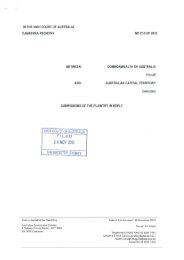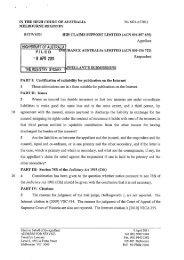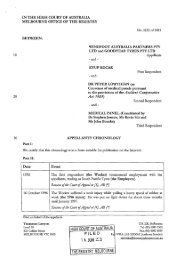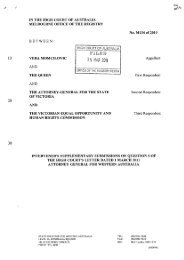Written submissions - High Court of Australia
Written submissions - High Court of Australia
Written submissions - High Court of Australia
Create successful ePaper yourself
Turn your PDF publications into a flip-book with our unique Google optimized e-Paper software.
18<br />
Huynh. Indeed, the <strong>Court</strong> below accepted that while, from time to time, the trial judge<br />
did link his directions as to matters <strong>of</strong> law to the facts, in doing so he did not<br />
differentiate between the three accused. 69 While this criticism applies to the oral<br />
summing up, it applies a fortiori to the written direction.<br />
79. In response to the contention that the trial judge failed adequately to link the directions<br />
as to the law to the cases against the individual accused, the <strong>Court</strong> below excused this<br />
failure on the basis that it was not necessary to provide this linkage in relation to each<br />
accused, and that to require otherwise would necessitate a substantial addition to the<br />
summing up, and to run the risk <strong>of</strong> unduly burdening the jury in terms <strong>of</strong> length and<br />
10 complexity. 70<br />
80. First, to suggest that it was not necessary to address the (differing) cases <strong>of</strong> the<br />
accused separately runs contrary to approach required by R v Towle (extracted above).<br />
81. Secondly, a distillation <strong>of</strong> the case against each <strong>of</strong> the accused need not have added<br />
unduly to the length and complexity <strong>of</strong> the summing up. The <strong>Court</strong> below was able to<br />
summarise the evidence and cases against each <strong>of</strong> the accused very succinctly in its<br />
reasons.' 1 Certainly there would have been no difficulty in separately and succinctly<br />
distilling the evidence and case against the appellant Huynh.<br />
82. Thirdly, and in any event, to the extent that a separate distillation <strong>of</strong> the cases against<br />
the individual accused would have added to the complexity <strong>of</strong> the summing up, this is<br />
20 not a matter which can or should be visited against the accused, or in some way<br />
compromise their entitlement to an appropriate summing up. If anything, it is a product<br />
<strong>of</strong> the prosecution adopting the undesirable approach <strong>of</strong> leaving multiple heads <strong>of</strong><br />
liability to the jury in respect <strong>of</strong> multiple accused. 72<br />
83. Fourthly, it is necessary to take into account the form <strong>of</strong> the jury's question. In the<br />
situation <strong>of</strong> oral redirections the courts have emphasized the need not only to be<br />
balanced,'' but also complete. The form <strong>of</strong> any question giving rise to a redirection<br />
will <strong>of</strong>ten dictate the level <strong>of</strong> detail required.<br />
84. In R v 0/asiuk (1973) 6 SASR 255 the jury, after deliberating for a couple <strong>of</strong> hours,<br />
returned with a question asking the trial judge to "define the definition (sic) between<br />
30 manslaughter and murder." In answering this question, the trial judge confined his<br />
69<br />
CCA [162].<br />
7<br />
° CCA [174].<br />
71<br />
CCA [20]-[23]; [159]-[161].<br />
72<br />
R v Tangye (1997) 92 A Crim R 545 at 556; R v Pham [2005] NSWCCA 9 at [109].<br />
73<br />
R v Gassy (2008) 236 CLR 293
















